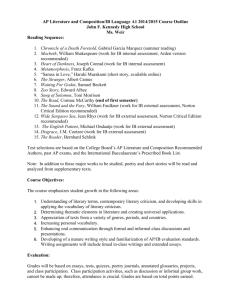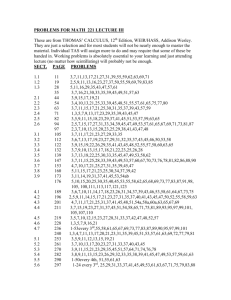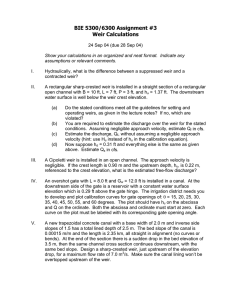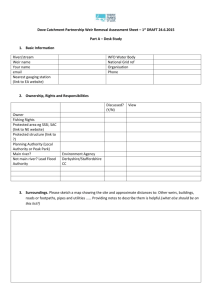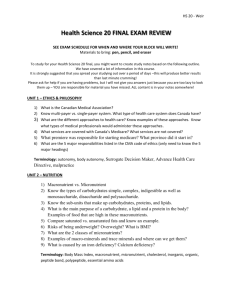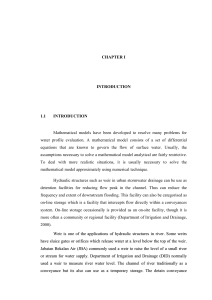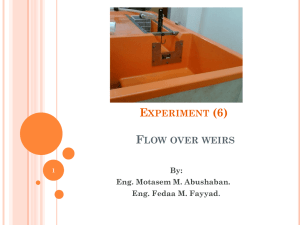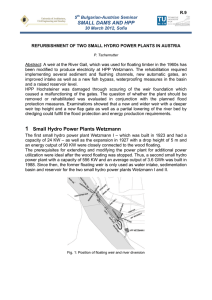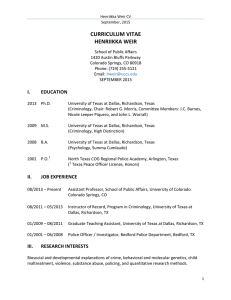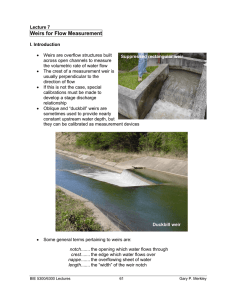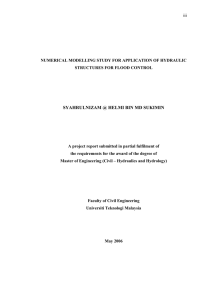Science 10: Chemistry Review
advertisement
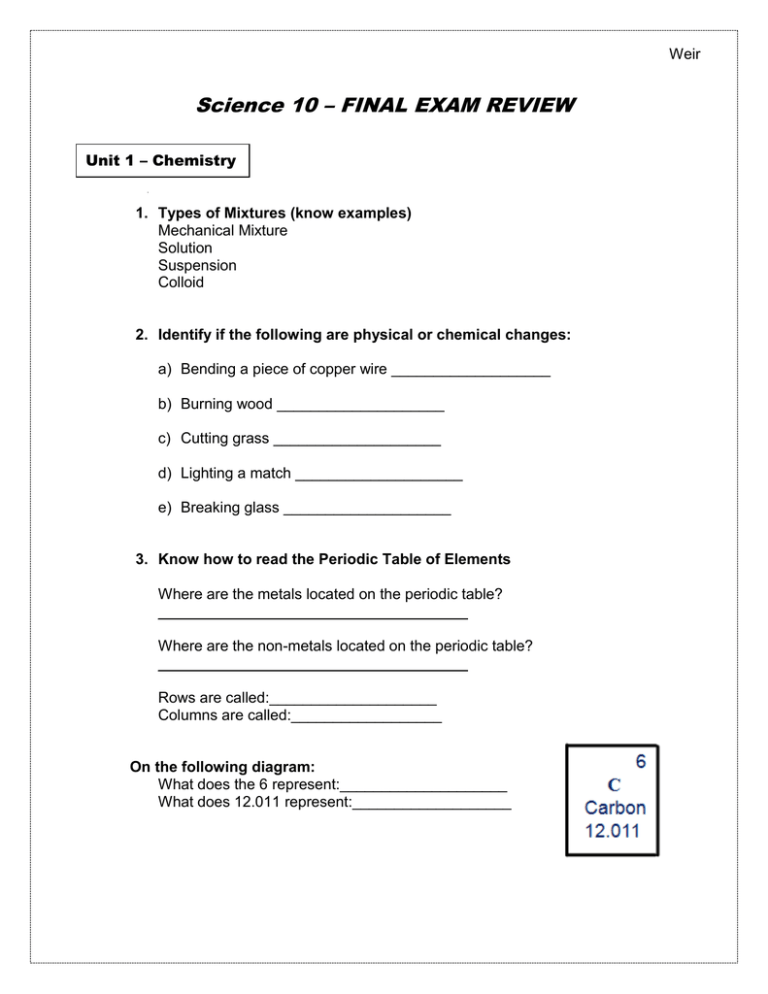
Weir Science 10 – FINAL EXAM REVIEW Unit 1 – Chemistry 1. Types of Mixtures (know examples) Mechanical Mixture Solution Suspension Colloid 2. Identify if the following are physical or chemical changes: a) Bending a piece of copper wire ___________________ b) Burning wood ____________________ c) Cutting grass ____________________ d) Lighting a match ____________________ e) Breaking glass ____________________ 3. Know how to read the Periodic Table of Elements Where are the metals located on the periodic table? _____________________________________ Where are the non-metals located on the periodic table? _____________________________________ Rows are called:____________________ Columns are called:__________________ On the following diagram: What does the 6 represent:____________________ What does 12.011 represent:___________________ Weir 4. Draw a Bohr model of Magnesium. . 5. Draw the Lewis Dot Diagram for a) Chlorine b) Lithium c) Aluminum 6. Complete this chart for the following elements Element Atomic Number Al B Ne S 7. Define: a) Ions: b) Cations: c) Anions: d) Polyatomic ion: Neutrons Protons Electrons Valance Electrons Weir 8. Determine the ionic charge that the following elements would have a) Lithium _________ b) Sodium _________ c) Nitrogen _________ d) Fluorine _________ e) Beryllium _________ f) Carbon _________ g) Iodine _________ 9. Give the names of the following ions: a) Mg +2 ______________________________ b) OH-1 ________________________________ c) S-2 ________________________________ d) Na+1 _______________________________ e) NH4 +1 _____________________________ 10. How can you tell when you have an ionic compound? _________________________________________________ 11. How can you tell when you have a molecular compound? _________________________________________________ 12. Name the following ionic compounds: a) K2S ___________________________________ b) Ag2O ____________________________________ c) AlBr3 _____________________________________ d) CaCl2 _____________________________________ e) Na3N ______________________________________ Weir f) LiOH _______________________________________ g) Na2CO3 ____________________________________ 13. Write the formulas for the following ionic compounds: a) Sodium oxide ___________________________________ b) Calcium Nitride __________________________________ c) Lithium Fluoride _________________________________ d) Sodium Phosphate _______________________________ e) Magnesium hydroxide _____________________________ 14. Name the following molecular compounds: a) CO ________________________________ b) PCl3 __________________________________ c) CCl4 _________________________________ d) N2O3 _________________________________ 15. Write the formula for the following molecular compounds: a) Dinitrogen tetraoxide _________________________ b) Phosphorus trichloride _________________________ c) Sulphide dioxide ____________________________ d) Carbon tetrafluoride ___________________________ 16. Balance the following chemical equations: a) ______ Br2 + ______ H2 _____HBr b) ______ N2 + ______ H2 ______ NH3 c) ______ Fe2O3 + ______ H2 ______Fe + ______ H2O d) ______ C10H16 + ______ Cl2 ______C + ______ HCl Weir 17. Know the 6 types of reactions. Give an equation to represent each type: a) Synthesis b) Decomposition c) Combustion d) Neutralization e) Double Displacement f) Single Displacement 18. Name and explain the 4 ways you can make a chemical reaction go faster, using collision theory. 19. What are the properties of Acids? 20. What are the properties of Bases? UNIT 2 – MOTION (PHYSICS) 1. Define: a. Distance b. Time c. Motion Weir d. Speed e. Acceleration 2. Calculate the slope of the following graph. Distance vs. Time 140 distance (m) 120 100 80 60 40 20 0 0 5 10 15 20 25 30 time (s) 3. Find the velocity if an object is moving 500 m in 55 seconds. 4. Find the distance if an object is moving 21 m/s for 35 seconds. 5. Find the time if an object travels 10 km/h for 475 km. Weir 6. Graph the following data to find the average velocity: Make sure to include all the parts of a graph (ie. Title, label axis, etc.) Distance 0 82 160 244 326 400 482 570 656 781 865 940 1023 1105 (m) Time 0 10 20 30 40 50 60 70 80 90 100 110 120 130 (s) 7. Describe the motion from the following Position – time graph: Weir 8. What is the formula for acceleration? 9. If a car accelerates to 56 km/h in 55 seconds, what is the car’s acceleration? 10. Explain the difference between uniform and non-uniform motion. Know what uniform motion looks like on a distance – time graph and what non-uniform motion looks like on a distance- time graph. Be able to sketch these 11. From the following graph, find the average acceleration. 12. Determine the following as a qualitative measurement or a quantitative measurement: a) The ice is cold:_____________________ b) The person weighs 110 pounds:__________________ c) The number of squirrels is 14: ___________________ d) The air smells like vanilla: ______________________ Weir 13. Use the DRUL rule to convert the following measurements: a) 300 m = _____________ km b) 560 km = _____________mm c) 434.5 km = ____________ hm d) 0.000 345 dag = ________________cg e) 1 360 000 cm2 = ______________________m2 f) 2345 dm3 = ________________________cm3 14. Write the following in scientific notation: a) 1258 = b) 0.54 = c) 56 = d) 0.000 03 = 15. Define: Average Speed Instantaneous Speed 16. A helicopter’s speed increases from 25 m/s to 60m/s in 5 seconds. What is the acceleration of the helicopter? Use GREAS 17. Know the difference between a distance vs. time graph and a speed vs. time graph. Know what positive, negative and zero slope mean and look like on each type of graph. Weir Unit 3: Climate and Ecosystem Dynamics 1) Define worldview and list some things that influence/create your worldview. 2) Contrast abiotic and biotic factors. Give an example of each. 3) What is the difference between natural and an artificial ecosystem? Give an example of each. 4) What is Sustainability? What are the two factors that affect the sustainability of the environment? 5) What is the difference between climate and weather? 6) What types of human activities have contributed to global warming? 7) Define: Conduction Convection Radiation 8) What are the natural greenhouse gases? Weir 9) What is a jet stream? 10) Define Biodiversity, what are the five factors that lead to biodiversity loss (HIPPO)? 11) What is a biome? List some of the biomes and their key characteristics. 12) The Carbon Cycle: a) What are the two complementary processes of the carbon cycle? b) Write out the reactants and products for both processes. 13) The Nitrogen Cycle What 2 methods are there for atmospheric nitrogen to be fixed into nitrates? Weir 14) Populations a) What are the four components that effect population growth? Provide a brief description of each. b) What is the difference between an open and closed population? 15) Limits on Populations a) Define Carrying capacity. b) What would happen if the population of field mice began to exceed the carrying capacity? c) Define Biotic Potential, and know the 4 factors that affect it. 16) Give some examples of Density Dependent and Density Independent) factors that limit population size. 17) Know the difference between linear and exponential population growth and what they look like on a graph. PREPARING FOR YOUR FINAL EXAM *Please use your in-class review time wisely and study at home over a period of days – this will produce better results than last minute cramming! *Please ask questions or arrange a time for extra help if you are having problems, but I will not just give you answers because you are too lazy to look them up or they are missing from your notes – YOU are responsible for material you have missed. *The best practice for calculation problems and naming/formulas for chemical compounds is to go back in your notes and REDO the numerous questions provided. Just “reading” through calculations or naming problems will not help you learn how to actually do them/name them. Extra practice problems can be provided if requested.
